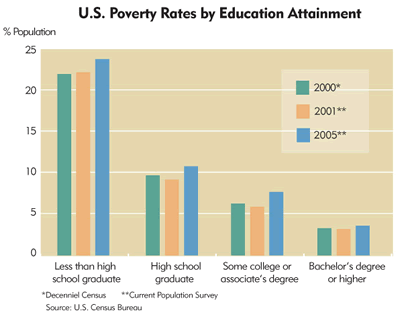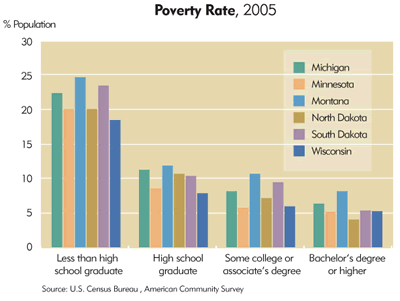Stay in school. The longer you do, the more likely you'll stay out of poverty.
That might not be a strong sell to kids worried about more immediate matters, but it's a simple axiom for policymakers hoping to make a dent in poverty rates.
Failing to graduate from high school is about the surest ticket a person has to poverty. There are about 190 million people in the United States over the age of 25, and about 19 million are in poverty. Those without a high school diploma make up 15 percent of the 25-and-over age group, but 35 percent of those in poverty.

In fact, though much is made of the loss of good-paying manufacturing jobs—the ones that could assure a middle-class living for those choosing work over college after high school—poverty rates even for those with just a high school diploma remain below the overall national average.
Still, more schooling is better, as employers pay higher salaries for those with greater skills, and is reflected in average poverty rates, which stair-step their way lower as people enter college and earn degrees. This pattern holds regardless of economic conditions, though the rates within a category can fluctuate considerably. For example, for people with some college but no four-year degree, poverty rates increased from 5.9 percent in 2001 to 7.7 percent in 2005.

This "education-poverty mold" fits district states as well, though individual states have somewhat different rates. Wisconsin's poverty rate in 2005 for those with a high school diploma or less is considerably lower than other district states and the nation, likely reflecting the continued strong presence of manufacturing in the state. Poverty rates for those in North Dakota with a bachelor's degree or higher are half the national rate, which is even more notable given the state's high college participation rate. On the other end, Montana's poverty rates are higher across the educational board, particularly compared to other district states.
| Editor's note: All comparisons over the period 1990-2005 use two U.S. Census Bureau surveys that are not directly equal, but offer the best available information over the period investigated. Data from 1990 and 2000 are from the decennial census and are the most reliable. Data after 2000 come from the American Community Survey, an annual Census Bureau survey that uses sample data. Research has shown that ACS data have a tendency to be biased slightly higher than decennial figures. |
Ron Wirtz is a Minneapolis Fed regional outreach director. Ron tracks current business conditions, with a focus on employment and wages, construction, real estate, consumer spending, and tourism. In this role, he networks with businesses in the Bank’s six-state region and gives frequent speeches on economic conditions. Follow him on Twitter @RonWirtz.





